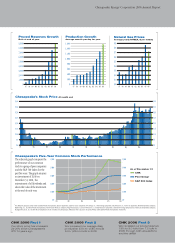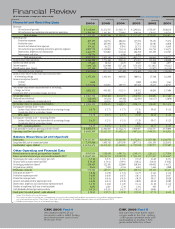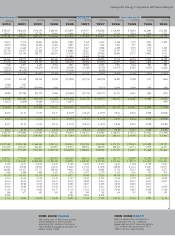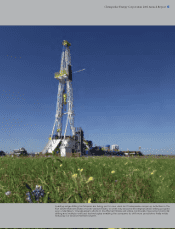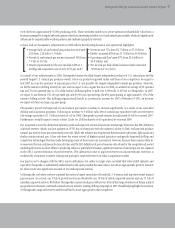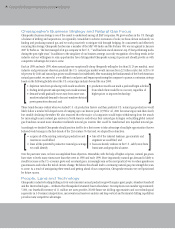Chesapeake Energy 2006 Annual Report Download - page 10
Download and view the complete annual report
Please find page 10 of the 2006 Chesapeake Energy annual report below. You can navigate through the pages in the report by either clicking on the pages listed below, or by using the keyword search tool below to find specific information within the annual report.
8
Chesapeake Energy Corporation 2006 Annual Report
•depletion rates from producing wells would accelerate;
•finding, development and operating costs would increase;
•demand would gradually move away from more cost-
sensitive industrial demand to less cost-sensitive electrical
power generation demand; and
•production would soon reach a peak and begin a decline
from which there would be no recovery, regardless of
higher prices or improved technology.
•acquire all of the existing natural gas production and
reserves we could afford;
•lease all the potentially productive natural gas acreage
we could identify;
•hire all of the talented landmen, geoscientists and
engineers we could find; and
•focus exclusively onshore in the U.S., safely away from
hurricanes and geopolitical unrest.
Chesapeake’s Business Strategy and Natural Gas Focus
Chesapeake’s business strategy is one of the easiest to understand among all E&P companies. We grow onshore in the U.S. through
a balance of drilling and acquisitions, we regionally consolidate to achieve economies of scale, we focus almost exclusively on
finding and producing natural gas and we work proactively to mitigate risk through hedging. By consistently and effectively
executing this strategy, Chesapeake has become a member of the S&P 500 Index and the Fortune 500, was recognized in January
2007 by Forbes as “the best managed oil & gas company in the U.S.,”4 and has been one of America’s top 15 best-performing stocks
during the past eight years.5 In addition to the simplicity of our business strategy, our early recognition of evolving trends in the
industry and our willingness to seize opportunities have distinguished Chesapeake among its peers and should provide us with
competitive advantages for years to come.
Back in 1998 and early 1999, when natural gas was exceptionally cheap (frequently selling for less than $1.25 per mmbtu), most
industry and government observers predicted the U.S. natural gas market would increase from 22 trillion cubic feet (tcf) to 30
tcf per year by 2010 and natural gas prices would remain low indefinitely. After examining the fundamentals of the North American
natural gas market, we arrived at a very different conclusion and began repositioning the company to pursue a contrarian strategy
based on the following beliefs about the U.S. natural gas industry beyond the year 2000:
These trends became evident when we studied U.S. oil production history and then predicted U.S. natural gas production would
likely follow a similar bell-shaped curve of ramping up to an historic peak (1970 for oil, 2001 for natural gas) and then slowly
but steadily declining thereafter. We also reasoned that the major oil companies would begin withdrawing from the search
for increasingly scarce natural gas reserves in North America and refocus their natural gas strategies on building global natural
gas franchises around more abundant worldwide natural gas reserves that could be transformed into liquefied natural gas.
Accordingly, we decided Chesapeake should position itself to be a first mover to take advantage of multiple opportunities that we
believed would emerge in the first decade of the 21st century. To that end, we adopted four objectives:
Over the past nine years, we have accomplished these objectives. Meanwhile, with the help of higher oil prices, natural gas prices
have risen to levels many times more than they were in 1998 and early 1999. More importantly, natural gas demand is likely to
steadily increase as the U.S. economy grows and as natural gas is increasingly seen as the most practical way to reduce greenhouse
gas emissions and reduce the risk of climate change. We believe this should lead to continuing natural gas price strength for years
to come. As a result of anticipating these trends and getting ahead of our competition, Chesapeake remains very well positioned
for future success.
People, Land and Technology
Chesapeake’s industry-leading drilling activity and consistent annual production growth require great people, abundant leasehold
and the latest technologies – attributes that Chesapeake fortunately has in abundance. Our employees now number approximately
5,000, our leasehold inventory of 11 million net acres provides 26,000 future net drilling opportunities and our technological
superiority in 3-D seismic interpretation, unconventional reservoir analysis and deep vertical and horizontal drilling capabilities
provides many competitive advantages.



